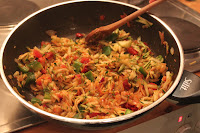This recipe makes about 14 cupcakes. We made 12 cupcakes and one mini cake.
1 1/2 cup flour
 3/4 cup sugar
3/4 cup sugar1 tsp baking soda
1 tsp cinnamon
1/2 tsp salt
1 egg, beaten
1/2 cup vegetable oil
1/4 cup milk
1 Tbs lemon juice
1 tsp vanilla extract
1 cup zucchini (peeled and shredded)
1/4 cup chocolate chips
1/4 cup walnuts, optional
Preheat the oven to 350 F (175 C)
 In one bowl mix flour, sugar, baking soda, cinnamon and salt. In a second bowl combine the egg, oil, milk, lemon juice, and vanilla. Mix well and then slowly mix into the dry ingredients.
In one bowl mix flour, sugar, baking soda, cinnamon and salt. In a second bowl combine the egg, oil, milk, lemon juice, and vanilla. Mix well and then slowly mix into the dry ingredients.
Once everything is mixed, fold in the zucchini, chocolate chips, and walnuts (we skipped the nuts because of allergies).

Fill muffin cups to be about 2/3 full. Bake for 20-25 minutes or until toothpick comes out clean (ours took 22 minutes).

See? That took no time at all. With both of us working in the kitchen we had our muffins out and cooling within 35 minutes.
Once muffins are finished let cool for a few minutes and then, if using silicone muffin cups, pop them out and let finish cooling.
Decorating:

If you are really short on time we suggest just sifting powdered sugar over the muffins. It is quick and makes them look very nice. Do this on the day you will serve them. Powder sugar which gets damp from the muffins no longer looks very nice.
If you have a bit more time we suggest making your own chocolate letters. This is much easier if you have a pastry bad and decorating tip but you can still make it work if you don't. We used a plastic bag and poked a tiny hole in the corner with a toothpick.
All you need to make chocolate letters is some chocolate (we used 50 grams of baking chocolate), parchment paper, a bowl, a bag, and somewhere to cool the letters quickly. Because she does not like (or trust) her own handwriting, she copied the text she wanted from the computer, wrote it out and put it under the parchment paper. This way she had a guide to follow. Using this method you can make an unlimited number of styles and designs.
Melt the chocolate for about 30 seconds on high in the microwave. After 30 seconds stir and if it is not completely smooth put it in for another 15 seconds.
Scope the chocolate into your bag of choice and make a very small hole.
Place your parchment paper on something hard which can also be moved (we used a flexible cutting board). This was you can pick up your chocolate and move it to the freezer without ruining your artwork.

Slowly pipe the chocolate onto your letters. Mess up? No worries! Just wipe the paper off and start again. DO NOT USE WATER! Water ruins the texture of chocolate and will make it very challenging (and ugly) to work with. Since you will be peeling the chocolate off the paper once it is hardened it does not matter if there are little blobs here and there that you do not like.
Once finished, put the entire paper (and board) into the freezer for about 15 minutes or until hard. Once it is finished you can easily peel the letters off of the paper and place them on the cupcakes/muffins.
We were going to make a chocolate icing to stick the letters in so they would be standing up and not flat but we ran out of time. Instead, we heated up the leftover chocolate and put a tiny dab on the back of each letter so they would stick to the muffin during the car ride.
If well planned, this entire process (baking the muffins to finishing decorating) should take under 45 minutes. Almost everyone has time for that.

































